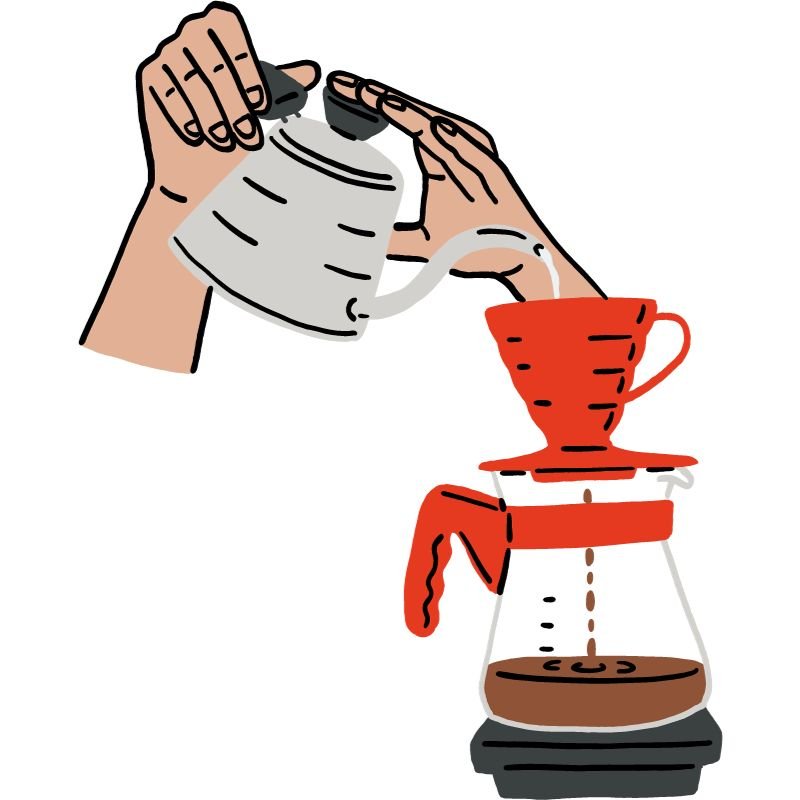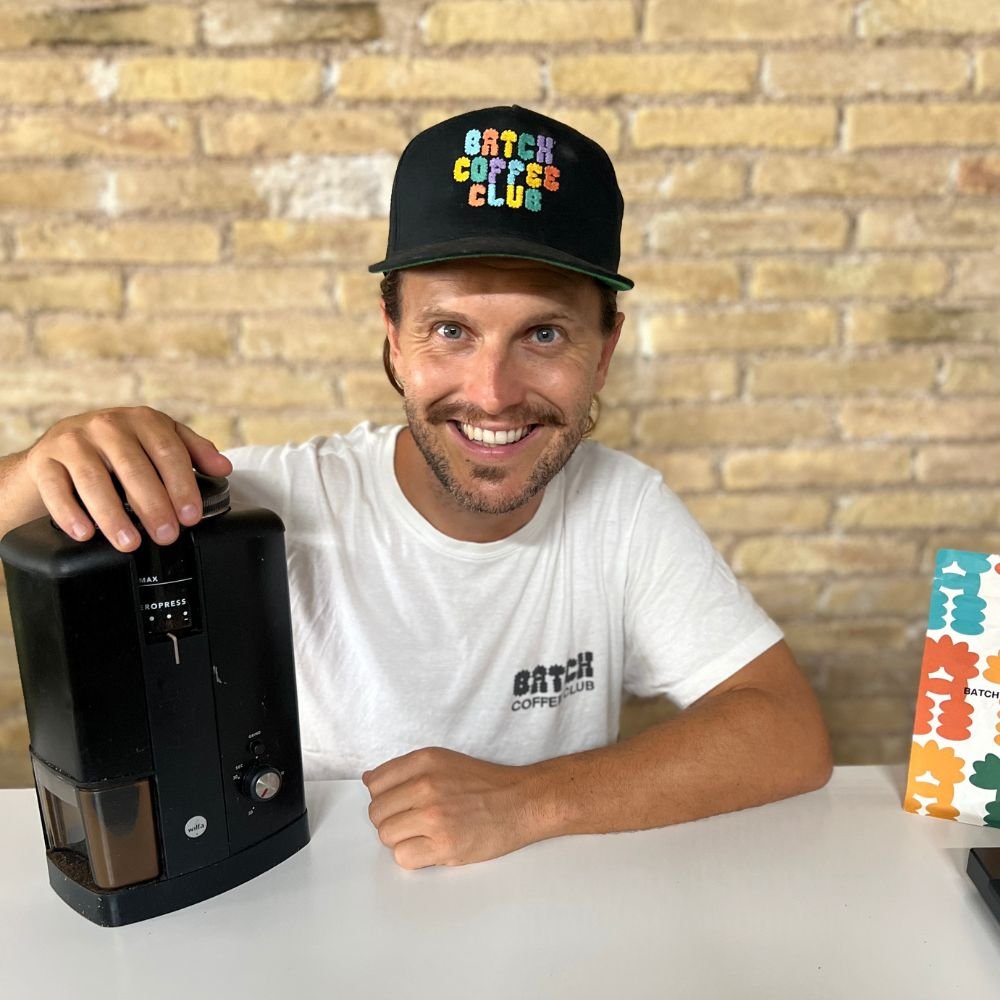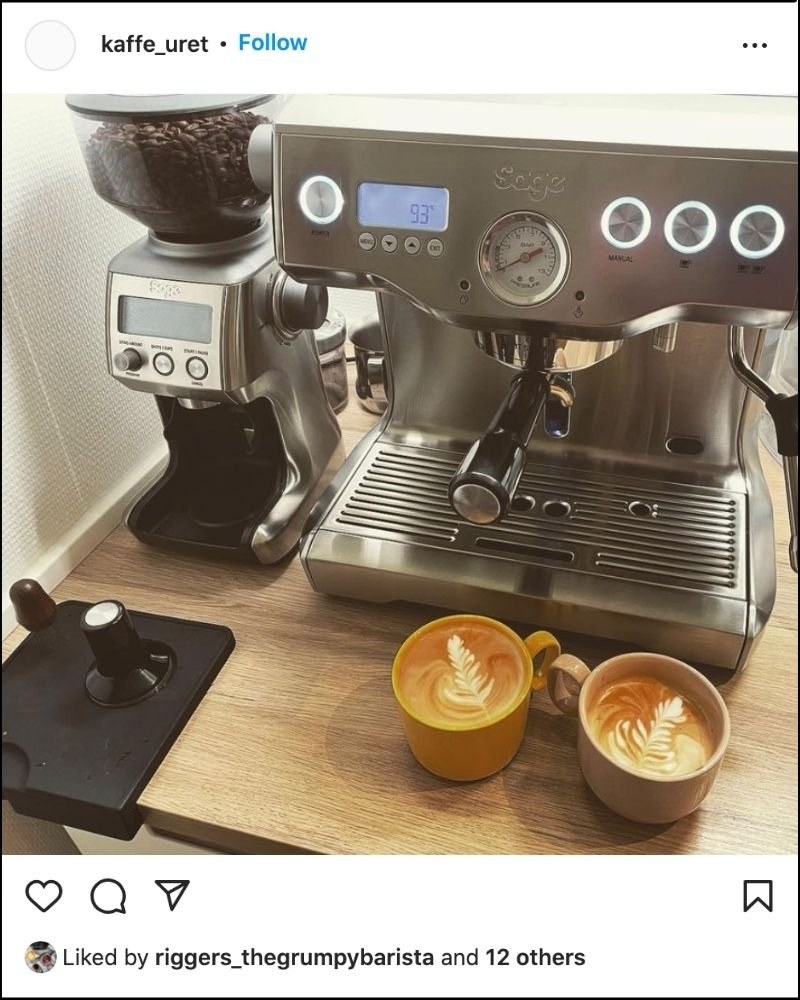The Best Coffee Grinders 2024 (Tom’s Top 8 Picks)
In my opinion a coffee grinder is one of if not the most important piece of coffee equipment.
The thing is, if you’re taken a step into specialty coffee and you can’t look at that jar of instant coffee the same anymore the only way is freshly ground coffee.
There's certainly an abundance of coffee grinders on the market today, varying in price, quality, and functionality.
I’ve worked with dozens of coffee grinders over the last decade both at home and as a barista so I’ll talk you through some of the best coffee grinders out there and what works best for different brew methods.
Why Trust Me?
Want to try some Batch Coffee… For Free?
We showcase some of the best coffee in the world (which tastes even better when freshly ground).
I’m that confident you’re going to love the coffee, I’ll send you a free trial box…
Different Types of Coffee Grinders: Blade vs Burr.
There are two types of grinders on the market: Blade and Burr coffee grinders.
Blade Grinders
Blade Grinders are essentially a coffee blender, coffee beans are placed in a container (a little like a Nutri-bullet) and whizzed up for a certain amount of time until the coffee resembles the level of coarseness required for your brew method.
The one advantage is that these are pretty cheap grinders but in terms of quality, they’re pretty poor.
The nature of blade grinders means there is no way to break up the coffee beans into consistent size particles and the resulting coffee grinds are of various sizes.
Inconsistently ground coffee, when brewed in any method, will result in large particles under extracting and small particles over extracting.
This will almost certainly lead to a below-par coffee.
Burr Coffee Grinders
Burr Grinders work by coffee passing through two mechanical burrs (either conical or flat, see below) that essentially crushes the coffee into small enough pieces to pass through and into a chamber where the grounds either collected in a box or caught in a portafilter.
A burr grinder is the industry standard for coffee grinders.
The consistent size of the coffee grounds alongside the ease in which you can adjust the coarseness makes it the only choice for anyone who wants to experience the delightful flavours speciality coffee offers.
The 2 Types of Burr Coffee Grinders
Conical burrs have a central cone-like fitting that revolves against the outer burr whereas flat burrs are two ring-shaped burrs that revolve parallel against each other.
There are arguments on both sides which type is more precise and efficient. The reality is that there is very little in it and both perform at a very high level of precision.
How to choose a Burr Coffee Grinder?
Manual or Electric?
I will cover electric burr coffee grinders in this blog but there are many manual burr grinders (or hand coffee grinders) on the market for those who want to grind coffee on the go or don’t have a huge budget.
Manual grinders often look like pepper grinders, rotate the arm to grind the coffee but make sure you have eaten your Weetabix as it does require a little bit of elbow grease.
You have so much control with a manual coffee grinder, you can adjust the grind size with loosing very little coffee (even the best electric coffee grinders need to be purged when altering the grind) and they are perfect for travelling with.
Electric burr grinders come in many shapes and sizes with a varying level of control, capacity and functionality.
Some grinders only grind to a medium setting and are geared towards filter methods, others have a mechanism to hold a portafilter and work best with an espresso machine.
We will cover all the options below.
Functionality
There are many grinders now that have more flashing lights and LCD screens that you can shake a stick at.
You essentially need the coffee beans ground to a certain level but it’s up to you whether you need some of the added extras that some machines offer, these include;
Preprogrammed grinds
Weighed grinding
Timed grinding
Ease of altering grind
Grind size adjustment steps
Price
Like with anything that requires quality parts, a decent coffee grinder in the UK can come with a decent price tag.
However, depending on your needs there is a grinder at every price point.
Coffee Grinder Buying Tips
- Check the grinder is built for your brew method.
This was touched on above but make sure the grinder will actually grind your coffee to the appropriate size.
This is specific to espresso grinds as there are some grinders that only grind to medium grind size and geared towards filter coffee.
Similarly, there are espresso grinders that have a portafilter (espresso machine handle-like part that holds the ground coffee) fitting so you can leave it in place until the grinder has stopped.
This is a bit of an issue for filter methods as you don’t have a portafilter to catch the grounds.
Coffee Grinders For Different Brew Methods
Espresso Grinder
Espresso machines need a fine grind level like table salt. It is important to check whether a grinder will be able to grind coffee fine enough.
Aeropress Grinder
An Aeropress coffee maker calls for a medium-fine grind size like the feel of sand. Most grinders will manage this level but consistency is key.
Pour Over Grinder
Any Pour over method like a Chemex or V60 needs a medium grind level like ground rock salt.
Cafetiere Grinder
A Cafetiere or French Press needs a coarse grind level for the optimum coffee.
The 8 Best Coffee Grinders
A couple of things quickly explained
Motor: We don’t list the motor RPM as although it is an important factor when buying a grinder it is often misused in marketing. One would think that a higher RPM is a good thing (Many commercial grinders spin at around 1450 RPM).
The higher the RPM in home coffee grinders, however, is not always a good thing.
High speeds produce static in the coffee grinds and pulverises the coffee bean leading to inconsistent grinds.
It also increases the popcorn effect of the coffee bouncing around the hopper.
There is certainly an optimum RPM in for home grinders when noise, output and consistency are taken into account, it’s usually somewhere between 250 and 450 RPM.
Grind Speed: This can be a little confusing as an espresso grind takes longer to complete than a french press also the size of the coffee beans makes a difference. A large bean varietal like a pacamara will take longer than say certain decaf beans that are smaller. So we don’t list this in our spec.
Wilfa - Svart
Control ★★★★★★★★★☆ 9/10
Grind Consistency ★★★★★★★★★☆ 9/10
Value For Money ★★★★★★★★★☆ 9/10
Brew Methods: Aeropress, Pour-Over, French Press
Burrs: Conical 40mm Stainless Steel
Dimensions: H312 x W200 x D155mm
Bean Hopper Capacity: 250g
Container/Portafilter Rest: Container
Features: Easy To Adjust, Discreet
Pros: ✅ Simplicity ✅ Value
Cons: ❌ Not For Espresso
Who doesn’t love Scandi design.
The Wilfa Svart grind is your go-to home coffee grinder (and mine) if you brew your coffee in pretty much any way other than espresso or stovetop.
It was designed in Norway with the idea to market this grinder to the filter methods crowd.
Because the burrs don’t have to operate at such a fine grind It comes in at an upper entry-level price point but creates a super consistent grind at the medium and coarse grind sizes.
The grinder is designed with style and the user in mind, simply rotate the bean hopper to adjust the grind and press go.
The grounds collect in the container at the bottom which can become a little messy as coffee sometimes sticks to the top of the lid, however, a few taps on the side of the container before opening usually solves this.
The slick design that fits easily onto your kitchen work surface combined with a pretty low RPM makes the Wilfa grinder discreet and quiet.
For me a great buy if you’re into any brew methods minus espresso and grinds coffee for Aeropress through to cafetiere brilliantly.
Read more in our Wilfa Svart Burr Grinder Review.
Or if you think that this is the Burr Grinder for you then
2. Sage - Smart Grinder Pro
Control ★★★★★★★★★☆ 9/10
Grind Consistency ★★★★★★★★☆☆ 8/10
Value For Money ★★★★★★★★★☆ 9/10
Brew Methods: All methods
Burrs: Conical 40mm Stainless Steel
Dimensions: H389 x W160 x D214mm
Bean Hopper Capacity: 450g
Container/Portafilter Rest: Both
Features: Programable, Consistent, Precise
Pros: ✅ Ease of Use ✅ Robust
Cons: ❌ Inconsistent Coarse Grind
Sage are one of the most well-known home coffee machine manufacturers today.
They showcase an array of espresso machines that have been expertly designed for kitchen worktops.
The Sage Smart Grinder Pro is their top of the range burr coffee grinder and one that Iove.
The grinder comes with fittings for two different portafilter sizes as well as a container to catch the grinds.
The LCD screen displays the grind time in milliseconds, the amount of shot desired and the grind size.
The 0.2-second adjustments in grind time make the dose extremely precise.
The 60 grind settings that the Sage grinder pro offers range from extremely fine (Turkish) through to extremely coarse (Plunger).
The grinder allows you to pre-programme settings so you can dial in various brew methods.
This Sage coffee grinder is simple to use straight out of the box, the intuitive dials on the front and side make adjusting the time and grind size easy.
The robust solid design makes it feel like a professional grinder.
There is little difference in the coarseness of the coffee grinds when I get past a certain level, so using this for methods that require courser settings like a french press may not be as accurate.
For a mid-range price point, you get a well-built home grinder that performs across all grind settings and is super easy to use.
Check out our comparison article on the Sage Coffee Grinders.
If the Sage Smart Grinder Pro is up your street,
3. Melitta - Calibra
Control ★★★★★★★☆☆☆ 7/10
Grind Consistency ★★★★★★★★★☆ 9/10
Value For Money ★★★★★★★★★☆ 9/10
Brew Methods: Espresso (Pressurized Basket), Stovetop, Aeropress, Pour-Over, French Press
Burrs: Conical 40mm Stainless Steel
Dimensions: H374 x W120 x D227mm
Bean Hopper Capacity: 375g
Container/Portafilter Rest: Both
Features: Scales, Programable
Pros: ✅ Grinding Technology ✅ Value
Cons: ❌ Not Easy To Use
This guy is a pretty unique grinder for the price point and has a host of great functions.
First of all the large 375g hopper is loaded with coffee and the grind size is adjusted traditionally at the collar of the machine. The grind sizes range from 1 which is super fine through to 39 which is coarse.
The really cool thing about the Melitta Calibra is that it has an integrated scale, which means you can dose the exact amount of coffee for your brew.
This is something that not many home or professional grinders for that matter incorporate.
Simply set the grinder to measure the grind in grams rather than cups and select how much you would like to grind.
If you’re using this as an espresso coffee grinder then this function makes dialling it in super easy because one of your variables (weight) is constant so you can adjust the grind size without worrying about a coarser setting weighing more.
It has fittings for both a container and a portafilter which are easy to attach and clean.
The big downside for me with this machine is that although it has some great functions and is really user friendly it doesn’t quite grind fine enough if you are planning on using it with an espresso machine with standard baskets like the Sage Barista Pro.
4. De’Longhi - KG79
Control ★★★★★★★☆☆☆ 7/10
Grind Consistency ★★★★★★★☆☆☆ 7/10
Value For Money ★★★★★★★★★☆ 9/10
Brew Methods: Stovetop, Aeropress, Pour-Over, French Press
Burrs: Conical 40mm Stainless Steel
Dimensions: H160 x W130 x D260mm
Bean Hopper Capacity: 120g
Container/Portafilter Rest: Container
Features: Simple To Use, Cheap
Pros: ✅ Cheap ✅ Easy To Use
Cons: ❌ Not That Consistent
One thing I really like about the De’Longhi KG79 is how easy it is to use.
The see-through containers let me keep an eye on the grounds, and the cup selector is handy for getting just the right amount. It's not too noisy either, which is a plus in my book.
The compact size fits nicely on your kitchen counter without taking up too much space.
While it's great for everyday use, I did notice it might struggle a bit with super fine espresso grinds. Also, cleaning can be a bit fiddly, but that's pretty standard for coffee grinders.
5. Eurika - Mignon
Control ★★★★★★★★☆☆ 8/10
Grind Consistency ★★★★★★★★★☆ 9/10
Value For Money ★★★★★★★★☆☆ 8/10
Brew Methods: All Methods
Burrs: Conical 55mm Stainless Steel
Dimensions: H400 x W200 x D300mm
Bean Hopper Capacity: 300g
Container/Portafilter Rest: Both
Features: 55mm Burrs, LCD Display
Pros: ✅ Precise ✅ Capacity
Cons: ❌ Expensive
Eureka have been around the top of the grinder league for some time.
They are one of the leading manufacturers of coffee grinders and have been designing their elegant machines since 1920.
The Mignon I found was one of their most popular and easy to use machines. I love the stylish and compact design alongside some pretty flawless results puts this guy ahead of the pack.
The 55mm burrs enable a faster grind without sacrificing the quality of the coffee grounds.
The digital display allows for easy adjustments to the grinding time, so you can grind your coffee automatically with minimal effort.
The ACE system (Anti-Clumps & Electrostaticity) helps prevent clumping and ensures cleanliness and precise dosing.
To accommodate portafilters of different sizes, the catch fork on the Eureka Mignon can be adjusted to various heights beneath the spout. Additionally, for easier grinding with drip devices, the catch can be completely removed for increased clearance.
If the Eureka Mignon coffee grinder is for you, Check Price on Shop Coffee
6. Niche - Zero
Control ★★★★★★★★☆☆ 8/10
Grind Consistency ★★★★★★★★★☆ 9/10
Value For Money ★★★★★★★☆☆☆ 7/10
Brew Methods: All Methods
Burrs: Conical 63mm Stainless Steel
Dimensions: H311 x W122 x D211mm
Bean Hopper Capacity: Single Dose
Container/Portafilter Rest: Both
Features: Professional Burrs, Zero Waste
Pros: ✅ Professional Consistency ✅ Waste
Cons: ❌ Expensive
The Niche Zero grinder has been on the market for a few years now, designed by inventor Martin Nicholson, who observed that grinder designs had remained largely unchanged for 50 years, while most other technologies had evolved significantly during that time. He aimed to address several design flaws in the original grinder.
His primary goal was to create a high-quality machine that could match the grind consistency of commercial models while maintaining a smaller output.
This was achieved through the use of 63mm burrs paired with a motor that operates at 330 RPM and delivers ample torque.
The other issue that he addressed was the amount of coffee that usually gets stuck in the grind chambers, which would be used for the next brew.
This issue is fine in commercial grinders that are used frequently but a home grinder may not get used until the day after, resulting in some of the coffee you use been a day old.
This is also a problem when you change the grind size as you will have to purge the coffee in most grinders to see the change in the grind.
The niche grinds the coffee at an angle that has a direct path out resulting in no leftover grinds, hence Niche Zero.
I found that the Niche is certainly one of the best home coffee grinders on the market and was created for the home barista who wants a single dose shot (many other machines grind for a specific amount of time, the Niche grinder has an on/off switch so you need to weight the coffee beforehand).
Great for one or two people, especially if you’re using a home espresso machine. If you’re using a filter method and more than 2 it can take a little while to grind and you may not need the added pro benefits it offers.
If you are in for precise grinding Check Price at Niche
7. Fellow - Ode Brew Grinder
Control ★★★★★★★☆☆☆ 7/10
Grind Consistency ★★★★★★★★★☆ 9/10
Value For Money ★★★★★★★☆☆☆ 7/10
Brew Methods: Aeropress, Pour-Over, French Press
Burrs: 64 mm Professional-grade Flat Burrs
Dimensions: H239 x W105 x D241mm
Bean Hopper Capacity: Single Dose
Container/Portafilter Rest: Container
Features: Stylish, Consistent, Well Designed
Pros: ✅ Design ✅ Ease of Use
Cons: ❌ Only For Coarser Grinds
The Stunning monolithic Ode Coffee Grinder.
Created by Fellow, pioneers in coffee brewing equipment, the Ode began gracing kitchen countertops following a successful Kickstarter campaign.
This design intentionally omits a bean hopper for more efficient use of space. Simply load your pre-weighed coffee into the top of the grinder, adjust the grind size using the large wheel on the front, and press start.
For me the impressive 64mm flat burrs are a standout feature that distinguishes this grinder from its competitors, as flat burrs are often regarded for their superior consistency.
Every detail has been carefully considered in the design of this grinder, from the knock trigger on the side that ensures all grounds are directed into the container, to the magnetic base of the container and the rubber lid that keeps everything secure.
Definitely, an Instagramable machine (checkout my insta) that is a new take on how grinders can look. It will grind right the way down to a fine Aeropress grind but not really fine enough for stovetop.
Want to add style to your kitchen?
8. Krups - Expert
Control ★★★★★★★☆☆☆ 7/10
Grind Consistency ★★★★★★☆☆☆☆ 6/10
Value For Money ★★★★★★★★☆☆ 8/10
Brew Methods: Espresso (Pressurized Basket), Stovetop, Aeropress, Pour-Over, French Press
Burrs: Conical 40mm Stainless Steel
Dimensions: H270 x W125 x D160mm
Bean Hopper Capacity: 225g
Container/Portafilter Rest: Both
Features: Small Coffee Grinder, Simple
Pros: ✅ Cheap ✅ Small
Cons: ❌ Quality of Grind
A classic entry-level grinder.
The Krups Expert for me stands out as one of the top options among budget-friendly burr grinders available.
I thought Its price is quite affordable considering the quality of the components used in burr grinder engineering. While the Krups Expert doesn’t deliver the grind quality of a mid-range burr grinder, it certainly outperforms a blade grinder.
This grinder features 17 grind size settings, ranging from fine to coarse, which I found adjust on the side of the machine. You can also set the grinding time using the dial located on the front.
It produces coffee with a decent consistency but may create some mess. It doesn’t grind fine enough for traditional espresso machines, though it might work with a lower-end machine that uses a pressurized basket, allowing you to extract a shot.
Overall, if you’re brewing anything from stovetop to French press and are on a budget, this grinder is a great choice. It offers significantly better results than a blade grinder, with plenty of potential for improving your coffee quality in the future.
Don’t just take our word for it.
Check out coffee legend James Hoffmanns breakdown of coffee grinders.
Not in the UK?
If you happen to be the other side of the pond to Blighty and you stumbled across this article you’ll notice that some of the grinders listed either aren’t available for you to purchase or the shipping is crazy.
Checkout this awesome coffee grinder guide from our friends over at Roasty Coffee.
Coffee Grinder Brands
Sage
Listen. Obsess. Innovate. Test. Refine. Design.
These 6 six words are what exactly what Sage are about.
Their range of appliances covers the entire kitchen, including toasters, microwaves, and blenders, all the way to high-end domestic coffee grinders.
They have clearly taken customer feedback into account, designing coffee grinders that produce delicious coffee with minimal effort while still allowing for some user control.
They feature some of the finest espresso grinders available, perfectly pairing with their exceptional line of Sage espresso machines.
The appliances showcased by Sage are designed not only for functionality but also for durability.
They are designed well and designed to last with all of their products robust and able to handle those with particularly heavy hands.
Melitta
The German-based coffee machine manufacturers have been around for over 100 years, they are famed for inventing the paper cone filter that you can still buy today in various forms.
They showcase a number of home espresso machines that mainly fit into the super-automatic bean to cup coffee machine category.
Melitta are also currently sponsors of one of, if not the greatest football team of all time, Manchester United.
What Is Happening When We Grind Coffee?
First off a bit of science.
We grind coffee to break the roasted coffee bean down to a particular size so we can brew the fragments of coffee (otherwise known as coffee grounds) with water to make a coffee.
There are however many different brewing methods of coffee brewing calling for various grind sizes to make the best-tasting optimum cup of coffee. The size of the grind is hugely important to the taste of your coffee according to the NCA.
For example, espresso coffee works best with finely ground coffee while a cafetiere or French press tastes better with coffee ground coarser.
When water is in contact with the coffee it is essentially extracting soluble flavour compounds from the coffee grounds resulting in brewed coffee.
The size of the coffee particle has an effect on what compounds are extracted, large coarse particles take longer to produce the balance of flavours because of the smaller surface area so is often associated with under-extracted coffee.
Whereas smaller particles collectively have a larger surface area which takes less time to extract the optimum flavour profile so can often taste over-extracted and bitter.
Why do you need a coffee grinder?
It is obviously possible to buy your coffee pre-ground and forget all of this nonsense about a coffee bean grinder but hopefully, if you’re reading this you’re aware of the benefits of freshly ground coffee.
Just to remind you why you need a grinder:
Once the coffee is ground it starts to deteriorate in quality and lose its flavour profile.
For finer grounds like espresso, this can happen almost instantaneously whereas coarser filter grounds take a little longer (we’re still talking in minutes though).
This is because when the surface of the coffee grounds come into contact with air for the first time the compounds start to oxidise and effectively create different compounds altering the delicate complexity and balance of the coffee.
According the The SCA there is a twenty fold staling acceleration difference between 0% oxygen and average sea level oxygen concentrations.
The oils and CO2 are also affected by the moisture content in the air which all adds up to the overall quality of coffee becoming somewhat depleted.
Grinding your coffee right before you brew triggers all of these chemical reactions that actually add to the brewing if the coffee is fresh.
Is it worth grinding your own coffee?
It ultimately hinges on how deep you want to dive into your coffee experience.
If you’ve made it this far down the page, it seems you’re contemplating the purchase of a burr coffee grinder and are already enthusiastic about improving your coffee.
Once coffee is ground, its quality begins to decline immediately; the air interacts with the compounds and oils in the grounds, leading to oxidation and altering the delicate balance of flavor notes.
Of course, you can purchase pre-ground coffee that still tastes good, or you can grind your own and enjoy it weeks later while still detecting some of the fruity notes.
But the fresher the ground coffee the better the coffee will taste.
Read our article on Does Grinding Your Own Coffee Taste Better?
Is a Coffee Grinder The Same As a Spice Grinder?
A spice grinder is very similar to a coffee grinder and manual grinders are extremely similar.
We would advise against using your coffee grinder to grind spices as various spices have greater oil content which may clog up the bean burrs. Plus you don’t want your floral Ethiopian coffee to taste like cardamom.
Can You Blend Coffee Beans?
Blending coffee beans will result in a lot of uneven fragments of the coffee bean. When you brew the ground coffee some of the coffee grinds will under extract and taste sour, while others will over-extract and taste bitter.
Overall the coffee will taste crap, unless you’re buying crap beans then the coffee will taste crap anyway.
By all means, try blending coffee though (most blenders will be able to handle coffee beans) and then grind the coffee with one of the burr grinders mentioned above and taste the difference. Check out Blending coffee without a grinder.
When To Clean Coffee Grinder?
If your grinder starts to produce inconsistent grinds, becomes slower or sounds strange then try to give it a clean.
You should also give your grinder a clean after it has ground around 20 kg. Different grinders have different needs however, some are generally quite clean while others create a great deal of mess.
How To Clean a Burr Coffee Grinder?
Most coffee grinders have similar components minus a couple of outliers.
So first take the bean hopper off the top of the grinder and give that a clean in the sink with water (make sure it is completely dry when you reassemble).
Now depending on the brand take out the burrs by either unscrewing the collar or unlocking the mechanism. These can be cleaned with a dry cloth or a toothbrush to remove any coffee grounds and oils.
For any parts that don’t come out use your vacuum cleaner to suck all of the coffee grounds out and then an earbud or a paper towel to clean away all of the extra fine grinds and the oils.
Where Can You Buy a Coffee Grinder?
You are able to buy a coffee grinder at many high street shops, I have even seen the odd coffee grinder at Tesco. Make sure you always check to see if it is a Burr or Blade grinder as many of the cheaper options tend to be blade. You can purchase some of the best burr grinders online, check out the list above with some of our favourites or our coffee grinder guide.
Why Are Burr Coffee Grinders More Expensive?
This is because the materials (usually of the burrs) are of very high quality.
The engineering and design of more expensive burr grinders is also very high quality to enable the precise grind level needed for certain brew methods.
What Happens if You Grind Coffee Too Fine?
Your coffee will taste bitter and over extracted if you hand grind your coffee too fine for your required brew method.
Sometimes you may not even be able to brew the coffee if the grind is too fine as water will not be able to pass through the coffee grounds, this is common in stovetop and espresso coffee.
Checkout Is it better to grind coffee fine or coarse?
How Long Does A Burr Grinder Last?
Burr grinders, if well maintained and kept clean should last around 5 years on average.
This amount of time can alter though and can depend on the amount of use, the brand of coffee grinder, where it is usually operated and the type of coffee beans that are normally used.
Can You Replace The Burrs On A Coffee Grinder?
In a commercial setting such as a speciality cafe a coffee grinder may need new burrs from time to time. After a certain amount of time and use, coffee burrs can become blunt/flat and need replacing.
This can also happen to a domestic coffee coffee grinder in your home, however replacement burrs can be hard to find or the coffee grinder may be constructed so you cannot remove the burrs.
It is quite unlikely that you would need to replace the burrs on your home coffee grinder however, as they are made to far outlast the average lifespan of a coffee grinder.




































